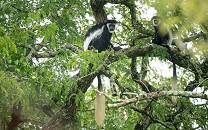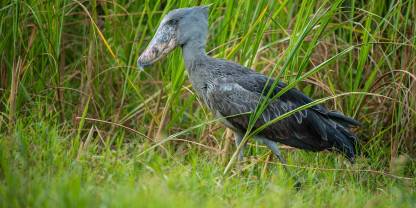Toro National Park (formerly Toro-Semliki Wildlife Reserve), despite being Uganda’s oldest protected area, retains an appealing off-the-beaten-track feel. It is located in the Semliki Valley, a scenic region hemmed in by the Rwenzori foothills and Lake Albert. Wildlife numbers are low, but this is one of the best places anywhere in Uganda to look for the localized forest elephant and giant forest hog. The park is of great interest to birders for the chance to see shoebill and visit nearby Semuliki National Park.

-
Best Time To Go
- December to March and June to August (Dry and early Wet seasons)
-
High Season
- June to September (Peak time for Uganda)
-
Size
- 543km² / 210mi²
-
Altitude
-
619-1,462m /2,031-4,797ft
 View Photos
View Photos
 View Photos
+6
Photos
View Photos
+6
Photos
Pros & Cons
- Excellent birding, with shoebill
- Seven primate species including chimpanzee
- The only lodge inside the park offers an exclusive bush experience
- A good base for day trips to Semuliki NP
- Night drives in the park and boat trips on Lake Albert are available
- Animal densities are low
- Limited accommodations
- Some roads become impassable in the rainy season
- Tsetse flies can be a nuisance
Wildlife
Toro is one of the few places where both of Africa’s elephant species (plains and forest) occur alongside each other. Lions were last recorded here in 2010, but leopards are sometimes seen during night drives. Chimps might be encountered on guided walks in Mugiri Forest. Other wildlife includes buffalo, Uganda kob, defassa waterbuck, giant forest hog, red-tailed monkey, black-and-white colobus and olive baboon.
More about Toro’s wildlifeScenery
Toro has a spectacular location in the Semliki Valley. This is a low-lying part of the Albertine Rift bounded by the Rwenzori Mountains to the south, the Rift Valley escarpment to the southeast, Lake Albert to the northeast, and the forested Congo Basin to the northwest. The park is dominated by woodland and , but there are also forest-fringed rivers and stands of .
Activities
tend to be most productive in the early morning (when elephants often cross the main road) and evening (for giant forest hog and leopard). Boat trips on Lake Albert provide a great chance to see shoebills close-up. On guided walks in Mugiri Forest you’ll sometimes encounter chimps. Birdlife is plentiful on all activities, but for dedicated birders a day trip to Semuliki NP is recommended. This national park hosts several forest species that are unrecorded elsewhere in Uganda.
Weather & Climate
Toro has a hot climate, with daytime temperatures typically peaking at 29°C/84°F and dropping to 19°C/66°F after the sun sets. The two main Wet seasons (March to May and August to November) bring little relief from the heat, despite lots of rain. Rain is still a possibility during the Dry seasons (December to February and June to July), but less likely.
More about the weather and climateBest Time To Visit
Toro is best during the Dry seasons and the months that immediately follow them: from December to March and June to August. This is because it becomes so difficult to explore the muddy terrain once the rains have soaked in. Of the two drier periods, December to March is best for birding as migrants are present. But you are more likely to see chimps over June to August, when forest trees are fruiting.
More about the best time to visit
